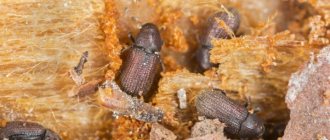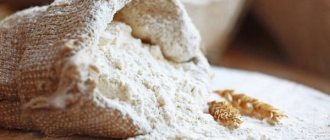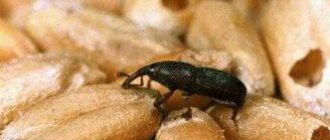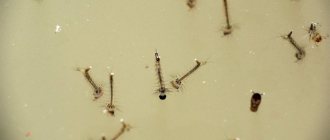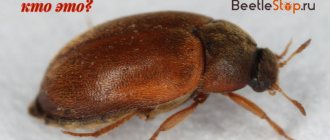Who are they, kitchen bugs?
When we see a beetle crawling out of a bag of cereal or flour, we don’t grab a microscope to examine it, but simply squeeze it.
However, among the parasites that attack our supplies, scientists identify three main types: red flour beetles, small flour beetles and bread borers. These are all kitchen bugs, and each of them has their own taste preferences. Major kitchen pests
Red mucoeds are small, 1.5-2.5 mm in length, rusty-yellow insects. They prefer flour, dried fruits, animal feed and corn grits. They live in groups, increasing the humidity of the product they infest with shells from larvae and excrement, which leads to rotting of the latter.
Small mealworms are reddish-brown in color, reach a length of 3.5 mm and have small wings. Insects do not fly, but they feel great throughout the kitchen. They can crawl into the narrowest cracks and uncovered containers. They settle in all types of cereals, from millet to semolina and buckwheat. They love flour and dried fruits.
Bread borers are the most tenacious of kitchen bugs, highly fertile and voracious. Externally they look like small cylinders of light brown or reddish-brown color up to 3.5 mm long. Grinders are so omnivorous that traces of their presence can be found in the bindings of books, and in cans of coffee, and in bags of cereal.
Bread affected by bread grinders
The Suriname flour beetle is another prominent representative of kitchen bugs. It has dark brown chitin, long antennae and an oblong body. The females of this species lay eggs on the packaging of the product. Beetles live for about three years and during this time they can breed up to nine generations. It is difficult to fight them, since they easily tolerate sudden changes in temperature, are not afraid of long-term transportation and are prolific.
Indian moth. Among the destroyers of household supplies, the Indian moth occupies one of the main places. It is not a kitchen bug, but it spoils food no less effectively than they do. Scattering around the house, food moths lay their larvae in all the products stored in the cupboards. It is the insect larvae, which look like small white worms, that turn rice and buckwheat into shapeless mush.
The Indian moth is a very unpleasant neighbor
Woodlice
These insects have an oval body of light gray, white, beige or brown, convex on top, and consists of several segments. The bug has 7 pairs of legs and a hard shell, and in front there are antennae up to half the length of the body. In nature, woodlice love damp places, which is where they got their name, but sometimes they settle near human habitation. They can climb into the cellar and into some rooms in the house (bathroom or toilet) where there is high humidity.
You can see such insects in the toilet or bathroom only when you turn on the light at night, because during the day they hide in secluded corners. Woodlice feed on plant debris and can harm plants in the garden. Inside residential premises, they can live not only in the bathroom and toilet, but also in living rooms where there are decorative flowers in pots. Here they find not only water, but also food.
Penetrating into living spaces, woodlice can not only frighten people who are disgusted by insects that run quickly, but due to moisture and mold they become carriers of various fungal diseases, which pose a danger to human health.
White insects in the apartment - who are they?
While recognizing cockroaches and ants is not difficult, the appearance of strange little bugs causes serious difficulties, since in order to eliminate parasites, one must know their exact type.
Let's try to figure out who can start up in the house.
- The most common type of parasitic white insects in an apartment is silverfish (in common parlance - woodlice). It is a small wingless individual, an oblong body with numerous legs. In fact, the body of the parasite is not completely white, it is rather silver, but in sunlight it appears almost transparent. Such insects feed on starch and products containing it. Due to the fact that silverfish choose damp places, the main area where the insects will be located will be the bathroom or kitchen, especially the sink area.
- The sugar silverfish can be designated as a separate species; it most often appears in food warehouses, kitchen drawers with food, and libraries (since it loves book bindings and glued pages). Such insects come out only in the dark, so it is quite difficult to detect them.
- White midges most often appear on indoor plants; this insect is called a whitefly. It is almost impossible to prevent its occurrence, but it is very easy to escape from it - just treat the soil and affected leaves with a weak solution of manganese, repeating the procedure if necessary.
- Light-colored bugs in kitchen cabinets can be food midges; they feed on cereals and other bulk products, spread very quickly, and in a few days the pest population can increase several times. These insects can appear in an apartment due to improper sanitary conditions - high levels of humidity, the presence of crumbs and other debris. Having appeared in one product, after a couple of hours the midges will move to other places, and they actively infect even hermetically sealed products.
We suggest you read: How to get rid of cherry flies
Of course, there are other representatives of parasitic insects that can occur in an apartment; each species has its own means of control, but if you cannot determine the exact type of pest, use complex preparations that help get rid of any apartment parasites.
To combat insects in a residential apartment, it is better to use drugs that are safe for humans, although in some cases (especially when the area is massively populated by parasites) chemically active agents will still be needed.
- The fight against silverfish should be comprehensive - first, clean the area from dust, dirt and cobwebs, and then treat it with chlorine-containing household chemicals. After waiting for the surfaces to dry, wipe all corners and hidden places with a solution of copper sulfate; it is advisable to dry the area using a fan heater (for small areas, a regular hairdryer is suitable). After a couple of hours, final cleaning with vinegar water is required - ½ cup of regular vinegar per bucket of warm water.
- Sugar silverfish most often grow in bookcases and shelves with papers, so these areas should be given special attention to eliminate the pest. Books and magazines should be rearranged and emptied, as eggs may be laid in them, and bookshelves can be sprayed with lemon water or thoroughly vacuumed.
- To eliminate food white midges, you will have to throw away all bulk food: even if you do not see bugs there at the moment, this does not mean that the cereal is clean. There are already numerous parasite eggs in it, and in a few days the insects will appear again. After cleaning all the cans and boxes, you should carry out a comprehensive treatment of the kitchen drawers using a soda solution or store-bought insecticides. After a couple of hours, the furniture should be washed with soapy water and additionally sprayed
Modern aerosol preparations are suitable for combating any type of insect, so they can be used as a protective or prophylactic agent against any type of parasite.
Silverfish
Such small, long insects are able to move very quickly on their numerous legs, penetrating into the narrowest crevices. They instantly hide when the light is turned on. Silverfish multiply quite quickly, so they pose a problem for apartment owners.
Their diet includes various substances: wallpaper paste, mold fungi, book bindings, sugar-containing products, fabrics and leather (not synthetic), food scraps and even wet paper and rags. Due to their nocturnal lifestyle, silverfish are difficult to spot immediately.
These gray-white beetles appear from dampness and choose corners with high humidity to live. They are not dangerous for humans: they do not bite due to their too small mouth, and they do not spread bacteria.
The only harm such insects can cause is to the nervous system of people who are frightened by their rapid movement across surfaces, and if they also crawl over the body, then impressionable women may faint.
How to prevent bugs from appearing in the kitchen
Having discovered bugs in the kitchen, we involuntarily think about how they got to us. Don't blame yourself for being careless when cleaning or storing food incorrectly. Even with the most thorough cleaning of cabinets and proper maintenance of all containers with cereals and flour, you are not immune from the appearance of beetles. The fact is that insects come into the house with purchased products.
Millet infected with bugs
Everyone understands that most parasites come to us from the outside, from our environment. It's the same with kitchen bugs. The primary infestation of future cereals by beetles occurs during the period of growing, harvesting and transporting cultivated crops. Unscrupulous producers neglect heat treatment of products, store them without complying with standards, and thereby contribute to the colonization of ready-made cereals and flour with insect larvae.
Bugs especially often appear in the kitchen along with pasta, dried fruits, flour and cereals bought in bulk. This is due to the fact that loose products absorb moisture well, creating an ideal environment for the development of previously deposited beetle larvae. By placing such products next to packaged ones, you unwittingly contribute to their dispersal.
Sometimes, along with the bugs, another attack, small midges, may appear. The article “How to get rid of midges in the kitchen” will help you get rid of them.
We suggest you read: Furry bugs in the apartment - who are they?
In the fight against any parasites, an important role is played by preventive measures. To prevent bugs in the kitchen cabinet from becoming full-fledged masters, it is worth taking preventive measures.
Store cereals in airtight jars.
- Dry the cereal brought from the store in a hot oven, up to 100 degrees, for 10-15 minutes.
- Use transparent jars with vacuum-sealed lids to store bulk products.
- Do not buy cereals and flour for future use, stock up for 1-2 months, no more.
- Add two or three cloves of garlic to the cereal bags. A natural antibacterial agent will prevent the appearance of bugs.
- Store dried fruits and nuts in the refrigerator.
- Place a few bay leaves in your cabinets. Place the laurel in the container with the cereal. The smell of this plant repels pests.
- When cleaning kitchen cabinets, treat the surfaces with an aqueous solution of vinegar.
Heating will help get rid of insects
You can also make a trap for beetles. Take a wide plaster and ground nutmeg. Cut the patch into pieces 3-5 cm long, sprinkle nutmeg on the sticky side and place the traps in the cabinets. This way you will quickly notice the presence of bugs and get rid of them in time.
Some housewives use ordinary nails in the fight against flour eaters and grinders. After washing and drying them, they place several nails at the bottom of the container with cereal. Surprisingly, small parasites cannot stand such a neighborhood and die before they have time to reproduce.
When fighting Indian moths, remember not to throw food spoiled by it down the garbage disposal. The pest larvae can linger on the walls of the garbage chute, hatch, and the butterflies scatter throughout the entire entrance. And then it will be much more difficult to remove insects migrating from apartment to apartment.
A couple of cloves of garlic will help you fight bugs
Such simple but effective measures will help you never see nimble and voracious pests in your kitchen.
Main types of insect wings photo and structure
The wing of an insect is formed by a modified fold of skin - the thinnest two-layer wing membrane, in which chitinized veins and modified tracheal vessels pass.
As you can see in the photo, there are three sides to an insect wing - the leading edge, the outer (outer) edge and the trailing (inner) edge:
Also, the structure of an insect wing includes three angles: the base, the apex and the posterior angle. According to the direction in the wing, the veins are divided into longitudinal and transverse. The basis of venation is made up of large, often branched longitudinal veins that reach the edges of the wing. Small, non-branching transverse veins are located between adjacent longitudinal ones. The veins divide the wing membrane into a number of cells, which are closed, completely limited by the veins, and open, reaching the edge of the wing.
The structure of the wings is considered in two main aspects: venation (the number and arrangement of veins) and consistency (the thickness and density of the wing plate). There are two main types of venation in insect wings. Reticulated is a dense, fine-mesh venation in which, in addition to longitudinal veins, there are many small transverse veins, forming numerous (more than 20) closed cells. Such venation is developed in dragonflies, orthoptera, lacewings and some other orders. The membranous venation is sparse, with a small number or absence of cross-veins; the cells are large and few in number. This venation is developed in most orders of insects (Lepidoptera, Hymenoptera, Diptera, Coleoptera, etc.). The venation of the fore and hind wings of insects is always the same.
Based on density, there are four types of insect wings. The most common are membranous wings, formed by the thinnest, transparent wing membrane. Only butterflies have membranous wings that are opaque, since they are covered with a layer of tiny scales. The hind wings of all insects are membranous, and in many (dragonflies, lepidoptera, lacewings, hymenoptera, etc.) both pairs are membranous. In a number of insects, the fore wings are compacted and serve as a protective covering. The front wings of orthoptera, cockroaches, mantises, and earwigs are called leathery. These wings are somewhat thickened, but not hard, opaque or translucent, always colored, and usually retain venation. The front wings of bedbugs are called semi-rigid, divided transversely into a compacted base and a membranous apex with developed veins. Such wings are active in flight and serve as a protective cover. Hard wings, or elytra, are the front wings of beetles. They are strongly thickened and chitinized, often hard, colored, and venation is completely lost. These wings, while providing reliable protection for the body, do not actively work during flight. Some forms of wings are distinguished by the nature of their pubescence, for example, fringed in thrips and scaly in butterflies.
Fighting methods
Depending on how heavily infested the products are with bugs, methods of combating them are selected.
Thorough cleaning of the premises is reliable prevention.
- We found two or three bugs in the rump, don’t be upset. Pour the cereal onto a baking sheet and heat in the oven at 100 degrees. The container will have to be destroyed and a new one prepared. Before cooking, rinse the cereal in additional salt water.
- If you're unlucky enough to spot a colony of little parasites in one of your cereal bags, you'll have to throw out the entire product, even if it's barely used. The ubiquitous bugs quickly settle in and inevitably look into open containers and find microscopic cracks in sealed packages. Therefore, you need to conduct a thorough audit of all supplies stored in cabinets.
- It is better to heat-treat visually undamaged products by placing them in the freezer of the refrigerator for two days. The bugs themselves easily tolerate -15 and 50 degrees, but the eggs they lay, which are difficult to notice with the naked eye, will certainly die from such exposure.
- To prevent re-infestation, you should wash the cabinets with disinfectant cleaners. For a better effect, you can wipe the shelves with a solution of 9% vinegar.
- Replace bags and sacks for all products that may become the target of bugs.
- Soak tin and plastic cans for half an hour in a saturated soap solution, then rinse them thoroughly with warm water and dry.
- All cracks in the floor, walls and window sill must also be treated. Check door hinges, drawer latches and shelf holders. Pour boiling water over them and wipe dry.
We suggest you read: What can get into the sofa and bite, where do insects come from?
Mole
These insects can spoil not only things in cabinets, but also food. Moth larvae and caterpillars are found in bulk products (flour, cereals); they may also take a liking to dried fruits. Moths multiply very quickly in an apartment, so you need to start fighting them immediately after detection. What methods of combating these insects are:
- Using repellents against butterflies. This could be a chemical compound - naphthalene, or it could be herbal remedies - geranium and lavender.
- A much more pronounced result is obtained by chemical treatment, for which dichlorvos is used.
No matter what insects that are resistant to poisons and influences pester you, you can still cope with them. But if you are already desperate to do it yourself, contact a pest control specialist. These guys know their stuff and can help even in the most advanced cases.
How do bugs get into the kitchen?
It is much easier to prevent the appearance of small parasites in a residential building than to eliminate colonies that have appeared on a massive scale.
- Firstly, avoid the accumulation of dust and dirt in the room, since small bugs most often appear in dusty places. To protect furniture from pests when wiping dust, you can use a polish; this product has a double effect - it removes dirt and repels insects with a specific smell;
- secondly, monitor the condition of pipes and risers in the apartment, eliminate condensation on windows and glass-ceramic surfaces, it is moisture that attracts woodlice and other types of silverfish;
- thirdly, periodically thoroughly ventilate the room, in this way you will saturate your living area with oxygen and help eliminate all egg clutches of insects laid by this time, since pests cannot tolerate cold;
- fourthly, to protect your apartment from the invasion of small pests, it is worth using such harmless products as soda, laundry soap, lemon when cleaning the premises - these components do not have a negative effect on humans, but they do an excellent job of controlling insects;
- fifthly, the use of herbs is considered an excellent means of preventing the appearance of insects in kitchen and wardrobes, as well as among books. Rosemary, lavender, walnut, eucalyptus have a pleasant smell for humans, but many insects cannot tolerate this aroma. You can use dry bunches of herbal mixtures, laying them out on shelves and under tables; for the same purpose, it is permissible to lay out unpeeled garlic cloves in kitchen drawers.
By taking precautions, you will not encounter the problem of removing insects from your apartment, so you should not neglect them, especially since all the proposed remedies are very simple and accessible to everyone without exception.
Chemical and folk remedies
To destroy white insects in the house, insecticidal aerosols are recommended, which should be used every week (Raid, Raptor, Dichlorvos, Clean House, etc.). When carrying out processing, personal protective equipment should be used (respirator or gauze bandage, rubber gloves on hands).
Insect control products
Folk remedies against silverfish and woodlice:
- scatter diatomaceous earth in the cabinets - a substance that kills crawling parasites; its solution can be used to treat cracks in the walls, tile joints, baseboards;
- scatter spices (cloves, etc.), essential oils or citrus zest inside the cabinet, which must be changed every 4 days;
- sprinkle boric acid powder mixed with chalk (in a ratio of 1:4) on the pipes, under the toilet and sink; the solution can be used to treat the surfaces of the pipes;
- against wood lice, it is also recommended to use a solution consisting of soda ash (3 g), tobacco powder and ground red pepper per 1 liter of water - this mixture must be sprayed in places where pests accumulate (plinths, ceilings, cracks and corners in the bathroom, toilet and cellar) ;
- To catch woodlice in flower pots, baits made from potatoes or carrots are used; to do this, cut out the middle of them and leave them overnight - when they get in there, the baits are destroyed along with the bugs.
Is it possible to eat bug-infested foods?
Faced with the infestation of food by kitchen bugs, the housewife is faced with a dilemma: throw away all the cereal or, after removing the bugs, use it further. Doctors do not recommend preparing porridge from grains infected with bugs. No matter how sorry you are for the products, you will have to part with them.
If bugs are found in flour, you can heat it in the oven at a temperature of 50 degrees for no more than 5 minutes. And only after that add it to dishes.
And keep in mind, even if you carefully sort through everything and warm up the cereal, it will be unpleasant for your household to eat porridge from it, knowing that there were beetle larvae in it. In addition, after the active life of the beetles, the cereal loses its taste.
flies
Which insects are capable of carrying pathogens and parasitic eggs and are often companions of humans? These are flies; their appearance at home, and especially near food, is unacceptable. What will help in the fight against them:
- If flies live near your apartment and fly inside, keep a fly swatter ready. Screens on windows help limit their access, like other insects.
- Hanging Velcro strips are a very effective solution. When a fly enters a room, the first thing it does is fly towards the pleasant smell of “Velcro” and does not have time to do any harm.
- Lovers of indoor plants can have geraniums, which repel flies. Sprigs of tansy placed in several places also help greatly with this.

